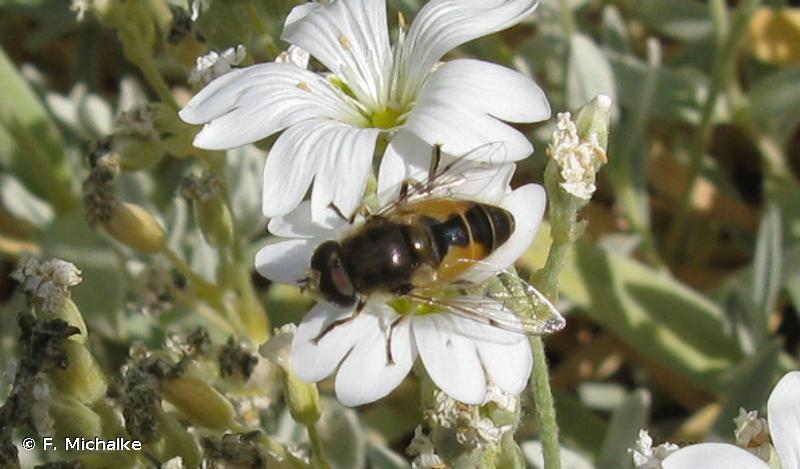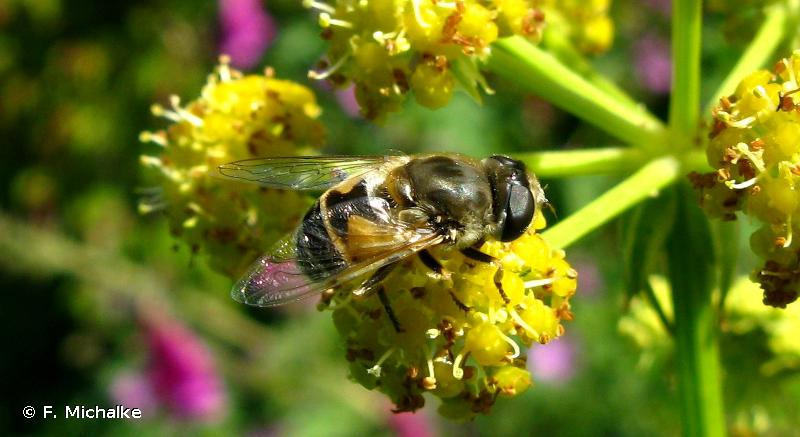
cd_nom

| Author : F. Michalke |
 |
To get the picture, please visit:
Friedrich Michalke
email : inpn@mnhn.fr
Despite the Creative Commons license, please inform the author of the use which will be made of his photo

| Author : F. Michalke |
 |
To get the picture, please visit:
Friedrich Michalke
email : inpn@mnhn.fr
Despite the Creative Commons license, please inform the author of the use which will be made of his photo
Taille :
Moyenne, 9 à 12mm.
Diagnose :
Le genre Eristalis n'est pas un genre facile à déterminer. Il se reconnaît grâce à ses callus huméraux poilus, ses antennes courtes, sa face noire, parfois pruineuse mais toujours dénuée de jaune ainsi que l'absence de taches sur les yeux. La nervation des ailes a aussi son importance notamment la première cellule radiale qui est fermée et la nervure radiale 4+5 fortement sinueuse. Eristalis arbustorum se distingue des autres espèces du genre par son arista plumeuse et sa face entièrement pruineuse de l'insertion des antennes jusqu'à l'épistome (bouche).
Facilité d'identification :
Difficile, examen à la loupe binoculaire indispensable.
Confusions possibles :
Confusion possible avec toutes les espèces du genre Eristalis, notamment Eristalis abusiva, nemorum, rupium et picea.
Période de vol:
Les adultes sont principalement visibles entre avril et octobre en plusieurs générations annuelles.
Répartition générale:
C'est une espèce présente dans toute l'Europe, de la Scandinavie jusqu'au pourtour méditerranéen (y compris l'Afrique du Nord). Vers l'est elle s'étend sur toute l'Asie jusqu'au Japon et en Chine. Elle est également présente en Amérique du Nord où elle colonise pratiquement la totalité des Etats-Unis et le Canada.
Habitat et biologie:
Espèce anthropophile on la rencontre partout dans les zones cultivées, les parcs et les jardins. Elle apprécie également les milieux naturels notamment les zones humides des forêts alluviales. Les adultes sont floricoles et visitent une très large variété de plantes. Les larves sont aquatiques ou subaquatiques, elles se retrouvent dans de nombreux types d'habitats d'eau stagnante de faible profondeur et riches en matières organiques qu'elles filtrent pour se nourrir. Elles peuvent aussi se retrouver dans les tas de fumier ou les fosses à lisier.
Speight, M.C.D. (2020) Species accounts of European Syrphidae, 2020. Syrph the Net, the database of European Syrphidae (Diptera), vol. 104, 314 pp., Syrph the Net publications, Dublin.
Thomas Lebard(),2021
Continental
Metropolitan France
Overseas
Marine
Metropolitan France
Overseas
The map presents a summary at the 10 x 10 km grid of the observation data for the species transmitted to the SINP. These data have been subjected to validation filters.
The map presents a reference distribution layer of the species at the scale of departments and marine sectors. The presence and absence data were established by expertise within a network of partners. This reference distribution is used in the validation process of the SINP data at the INPN level.
Corresponds to a report on the basis of at least one observation proved within a period of 10 years (20 years for little-known invertebrates) preceding the year and no presumption of extinction since obtaining the last data nor doubt on reproductive and implemented nature of this population. For migratory species, the presence indicated concerns areas of reproduction.
This status is based on one or more of the following criteria:
This point covers the absence, more difficult by nature to demonstrate than presence. This status is based on one or more of the following criteria:
This status must be assigned to a department in which the presence of the species is casual.
Particular case of absence due to a proven extinction less than a half century ago (older disappearances are treated as "no probable or definite").
In the state of knowledge, we can not comment on the presence or absence in the current department. This is the default status when not comprised in one of the previous categories or whenever there is doubt.
The map shows the global distribution of the species based on GBIF data (Global Biodiversity Information Facility).
